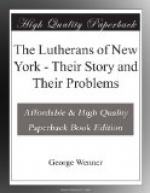This visible character of the Church is recognized in the New Testament in the various commands and promises given to her: the power of the keys, the duty to confess before men, to serve one another in love, of united intercession, of contending against the kingdom of darkness. In the Epistles the presence of sinful men is everywhere recognized, nevertheless the members of the Church are termed “the called” of Jesus Christ.
Lutheranism of the 16th century stood between two opposite errors, Rome on the one hand with its exaggerated ideas of the Church as an institution, and Reform on the other hand with its one-sided notions of the invisible church. The Lutheran Church took the via media, declaring that the Church, proprie, was spiritual, but that it was also an institution. The question for us is whether we Lutherans of the twentieth century have remained on the via media or whether we have not slipped too far to the right or to the left.
To find the answer one would naturally consult our church formulas and constitutions. According to Dr. Walther’s “Pastorale,” the candidate for admission to a “Missouri” church must be a truly converted and regenerated Christian. The General Council requires that the candidate shall have been admitted to the Lord’s Supper and shall accept the constitution. The Synod of New York requires that candidates be confirmed, accept the Augsburg Confession, lead a Christian life, obey the constitution and any other regulations that may hereafter be adopted.
From this it seems that “Missouri” is the only body that emphasizes the interna virtus. The others place the emphasis upon conformity with certain outward forms and requirements.
But we cannot always judge from the printed constitution. To bring the information up to date, and to ascertain the actual usage of the churches, the author obtained from forty pastors of this city an account of their practice. Some of their replies will be embodied in this chapter.
Theoretically we enter the church through baptism. Practically, for most Lutherans, confirmation is the door of admission.
This rite is a comparatively new measure among us. Prior to the eighteenth century it had only a limited use in the Lutheran Church, and it has attained an inordinately prominent place. Spener was among the first to recognize its practical value, and its beautiful ritual made a strong appeal to the popular imagination. It is one of the ancient ceremonies to which we do not object if it is properly used.
Now tell us, you who make so much of confirmation and so little of catechization, seeing that you are content with six months of the latter, in adopting a rite which Spener and the Pietists introduced into the church, have you also adopted the principles which governed Spener and the Pietists in the practice of confirmation? Their object in catechization and confirmation was conversion. “A stranger visited my class one day,” says Spener. “The next day he called to see me and expressed his great pleasure with my instruction. ‘But,’ said he, ’this instruction is for the head. The question is how to bring the head to the heart.’ And these words he repeated three times. I will not deny that they made such an impression upon me that for the rest of my days I shall not forget them.”




